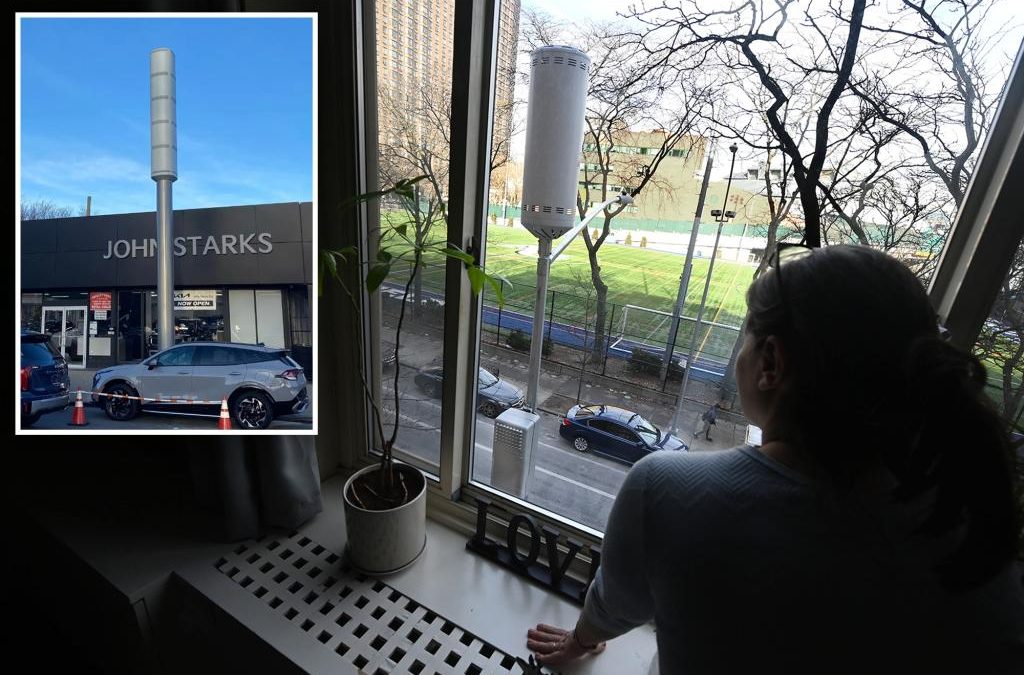New Yorkers overwhelmingly support erecting hulking 32-foot 5G cell phone antenna towers in their neighborhoods to bolster Wi-Fi service — far outnumbering critics who say the structures are an eyesore, according to a new poll.
The survey, conducted by Harris X Poll for LinkNYC, asked Big Apple residents: “Below is a picture of the new Link5G smart pole that will enable better 5G cellular coverage and free Wi-Fi connectivity around the smart poles’ locations. Would you support having one of these smart poles in your neighborhood?”
More than three-quarters of respondents — or 76% — said they support “smart poles” put up in their neighborhoods, while 12% were opposed and another 12% were unsure, the poll found.
New Yorkers were also asked, “How likely are you to use the free Wi-Fi, assuming there is a new Link5G smart pole in your neighborhood?”
About three of four respondents — or 74% — said they would likely use free Wi-Fi, while 18% they were unlikely to use it and the rest were unsure.
Another question posed to residents: “Which of the following statements better describes your view? The Link5G smart poles will provide needed benefits for my neighborhood and community. The Link5G smart poles will not provide an added value for my neighborhood and community.”
The response: 61% answered the 5G towers will provide needed benefits, while 18% said they would not provide added value and the rest were unsure.
About 2,000 of the 5G poles are to be installed throughout the city, with some having already gone up.
But opponents — particularly in the Upper East Side and Soho — claim the towers are ugly and out of character and they don’t want them in their neighborhoods.
The UES is home to historic, landmarked streets — such as the fashionable and touristy Park Avenue, Fifth Avenue and Madison Avenue shopping districts.
On Monday, residents of Carnegie Hill on the UES will join Rep. Jerrold Nadler and other lawmakers to protest the 5G towers and recommend alternatives.
Politicians and residents aren’t the only ones squawking about the 5G poles.
Former Knicks basketball star John Starks objected when the city had one of the structures installed smack in front of his Kia car dealership in Queens last year.
According to the poll, the staunchest supporters of 5G service were from the Bronx and Manhattan, and were millennials, parents, black men and Democrats.
The largest dissenters were from Staten Island, and middle income residents and seniors.
As The Post reported last week, a firm called Comptek proposed smaller, more elegant poles that can be affixed or connected to lampposts and better blend into the landscape than the 32-foot-high antenna towers.
LinkNYC service is being provided by CityBridge under a franchise agreement with New York. CityBridge is a group of companies comprising experts in technology, user experience, and connectivity.
To check the mobile wireless and internet needs of New Yorkers and measure awareness and support for Link5G smart poles, LinkNYC conducted the online survey among 1,617 New Yorkers from July 17th – 23rd.
The LinkNYC/CityBridge consortium said the poll’s findings show there is widespread support for the 5G towers, not opposition — and that protesters represent a small minority.
“It’s clear that in many neighborhoods across the five boroughs, new Link5G smart poles can’t
arrive soon enough,” said Nick Colvin, CEO of LinkNYC.
“LinkNYC is working closely with the City to ensure every New Yorker can access the high speed broadband necessary to thrive in our increasingly online society,” added Colvin.
“This new survey confirms nearly all New Yorkers rely on cellular networks to stay connected throughout their day, and most have experienced the frustration of poor data speeds and dropped calls,” he said. “We must prioritize the upgrades of our city’s telecommunications infrastructure that are necessary to improve existing services and required for New York City to remain a leader on the global stage — both technologically and in ensuring equitable access for all of our neighbors.”
Results of the poll were weighted by gender, region, race, age, income, and education to align with proportions in the population.
The poll has a margin of error of plus or minus 2.44 percentage points. Margin of error is larger among subgroups.
Source




